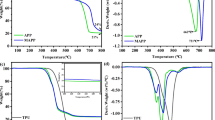Abstract
Intumescence is a versatile method for providing reaction to fire to materials. The incorporation of ammonium polyphosphate (APP) in polyurethane (PU) coating gives a highly efficient intumescent system. In this paper, it was shown that the addition of a small amount of nanoparticles (magnesium oxide or MgO, silica or SiO2, and silsesquioxane) in PU/APP enhances dramatically the fire performance. As MgO leads to the highest performance, the mechanism of action was investigated in detail. The beneficial effect of MgO is due to chemical reactions between MgO- and APP-yielding products (i.e., magnesium phosphate evidenced by solid-state nuclear magnetic resonance (NMR) of 31P) able to reinforce the intumescent structure. This incorporation of MgO gives a high char yield and more stable char. It is shown by X-ray tomography that the char developed with and without MgO during the intumescence process has different properties leading to different char morphologies and char expansions (with MgO smaller cells constituting the intumescent char and higher expansion obtained). MgO provides higher efficiency to the intumescence barrier, and hence, fire performance is strongly improved compared to the intumescent system without nanoparticle. Kinetic analysis of the intumescent systems permits to model their thermal decomposition. The beneficial effect of MgO is shown comparing simulated decomposition curves of PU/APP and PU/APP-MgO in the case of cellulosic fire.
Access this chapter
Tax calculation will be finalised at checkout
Purchases are for personal use only
Similar content being viewed by others
Abbreviations
- A :
-
Frequency factor (1/s)
- E :
-
Activation energy (kJ/mol)
- f(α):
-
Reaction model
- k :
-
Kinetic constant (1/s)
- t :
-
Time (s)
- α:
-
Degree of conversion (kg/kg)
References
Engels HW, Pirkl HG, Albers R, Albach RW, Krause J, Hoffmann A, Casselmann H, Dormish J (2013) Polyurethanes: versatile materials and sustainable problem solvers for today’s challenges. Angew Chem Int Ed 52(36):9422–9441
Bourbigot S, Le Bras M, Duquesne S, Rochery M (2004) Recent advances for intumescent polymers. Macromol Mater Eng 289(6):499–511
Gardelle B, Duquesne S, Vandereecken P, Bellayer S, Bourbigot S (2013) Resistance to fire of intumescent silicone-based coating: the role of organoclay. Prog Org Coatings 76(11):1633–1641
Xu ZZ, Huang JQ, Chen MJ, Tan Y, Wang YZ (2013) Flame-retardant mechanism of an efficient flame-retardant polymeric synergist with ammonium polyphosphate for polypropylene. Polym Degrad Stab 98(10):2011–2020
Duquesne S, Le Bras M, Bourbigot S, Delobel R, Camino G, Eling B, Lindsay C, Roels T, Vezin H (2001) Mechanism of fire retardancy of polyurethanes using ammonium polyphosphate. J Appl Polym Sci 82(13):3262–3274
Bourbigot S, Duquesne S (2007) Fire-retardant polymers: recent developments and opportunities. J Mater Chem 17(22):2283–2300
Opfermann J (2000) Kinetic analysis using multivariate nonlinear regression. I. Basic concepts. J Therm Anal Calorim 60(2):641–658
Samyn F, Bourbigot S, Duquesne S, Delobel R (2007) Effect of zinc borate on the thermal degradation of ammonium polyphosphate. Thermochim Acta 456(2):134–144
Bourbigot S, Bras ML, Delobel R (1993) Carbonization mechanisms resulting from intumescence association with the ammonium polyphosphate-pentaerythritol fire-retardant system. Carbon 31(8):1219–1230
Bugajny M, Bourbigot S, Le Bras M, Delobel R (1999) The origin and nature of flame retardance in ethylene-vinyl acetate copolymers containing hostaflam AP 750. Polym Int 48(4):264–270
Fayon F, Massiot D, Suzuya K, Price DL (2001) 31P NMR study of magnesium phosphate glasses. J Non-Cryst Solids 283(1–3):88–94
Feike M, Graf R, Schnell I, Jäger C, Spiess HW (1996) Structure of crystalline phosphates from 31P double-quantum NMR spectroscopy. J Am Chem Soc 118(40):9631–9634
McKee DW, Spiro CL, Lamby EJ (1984) The inhibition of graphite oxidation by phosphorus additives. Carbon 22(3):285–290
Mamleev V, Bourbigot S, Le Bras M, Duquesne S, Sestak J (2000) Modelling of nonisothermal kinetics in thermogravimetry. Phys Chem Chem Phys 2(20):4708–4716
Mamleev V, Bourbigot S (2005) Modulated thermogravimetry in analysis of decomposition kinetics. Chem Eng Sci 60(3):747–766
Mamleev V, Bourbigot S, Le Bras M, Yvon J, Lefebvre J (2006) Model-free method for evaluation of activation energies in modulated thermogravimetry and analysis of cellulose decomposition. Chem Eng Sci 61(4):1276–1292
Burnham AK (1999) Global kinetic analysis of complex materials. Energy Fuels 13(1):1–22
Bourbigot S, Gilman JW, Wilkie CA (2004) Kinetic analysis of the thermal degradation of polystyrene-montmorillonite nanocomposite. Polym Degrad Stab 84(3):483–492
Acknowledgment
The authors are indebted to Drs. Giacomo Giannini, René Klein, and Chris Lindsay for helpful discussions. Authors also thank Huntsman for financially supporting this research.
Author information
Authors and Affiliations
Corresponding author
Editor information
Editors and Affiliations
Rights and permissions
Copyright information
© 2017 Springer Science+Business Media Singapore
About this paper
Cite this paper
Bourbigot, S., Muller, M., Duquesne, S. (2017). Fire Behavior of Intumescent Polyurethane: Synergy, Morphology, and Kinetics. In: Harada, K., Matsuyama, K., Himoto, K., Nakamura, Y., Wakatsuki, K. (eds) Fire Science and Technology 2015. Springer, Singapore. https://doi.org/10.1007/978-981-10-0376-9_62
Download citation
DOI: https://doi.org/10.1007/978-981-10-0376-9_62
Published:
Publisher Name: Springer, Singapore
Print ISBN: 978-981-10-0375-2
Online ISBN: 978-981-10-0376-9
eBook Packages: EngineeringEngineering (R0)




